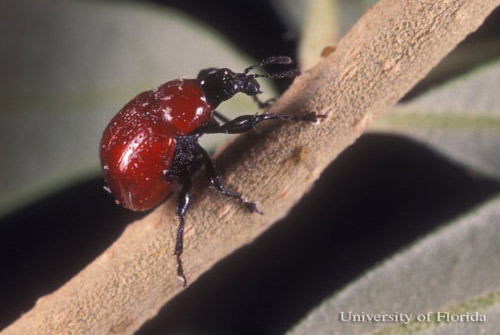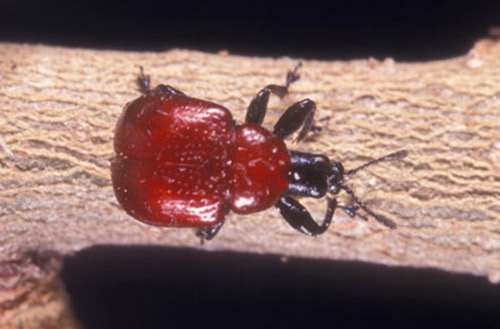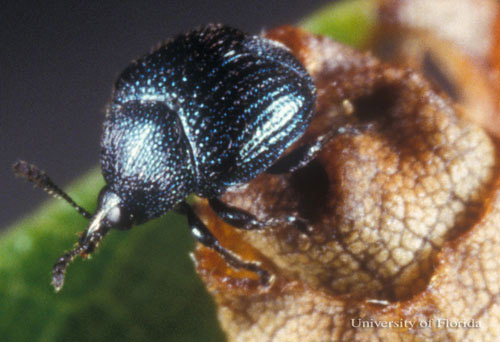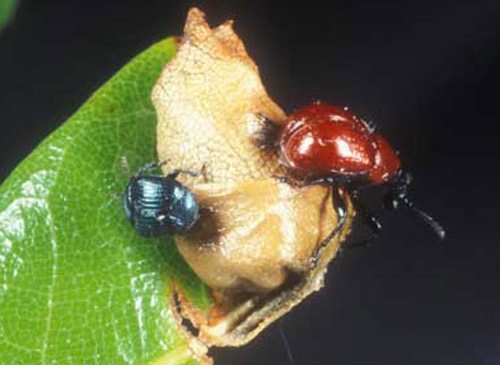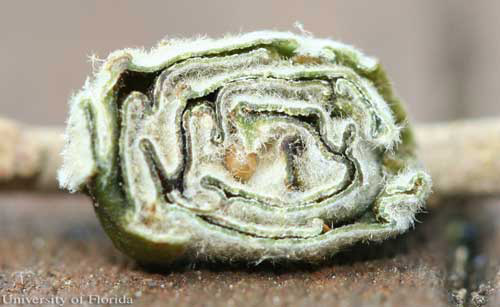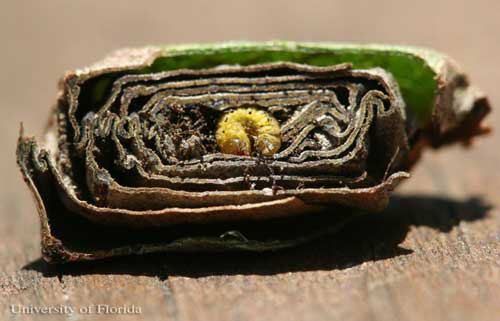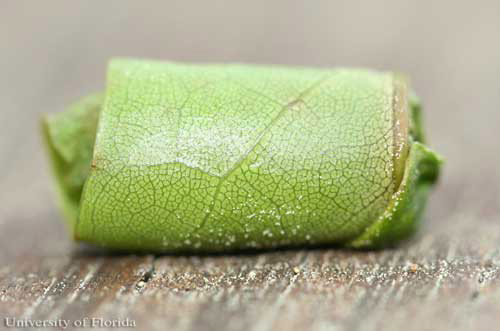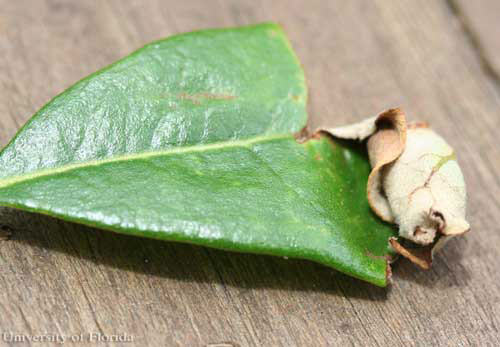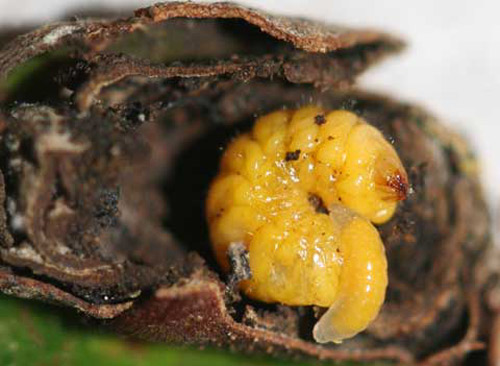common name: leaf-rolling weevil
scientific name: Homoeolabus analis (Illiger) (Coleoptera: Attelabidae: Attelabinae)
common name: thief weevil
scientific name: Pterocolus ovatus Fabricius (Coleoptera: Attelabidae: Pterocolinae)
Introduction - Distribution - Description - Life Cycle and Biology - Management - Selected References
Introduction (Back to Top)
Homoeolabus analis (Illiger) is one of a large number of New World and Old World leaf-rolling weevils in the family Attelabidae. The leaf-rolling weevils provide fascinating examples of complex, genetically determined behaviors. The leaf roll of an attelabid is referred to as a nidus (plural, niduses or nidi: verb, nidify) - the Latin word for "nest". The process of constructing the leaf roll is termed "nidification".
Pterocolus ovatus Fabricius is an obligate egg predator and nidus kleptoparasite (nest thief) of Homoeolabus analis.
The leaf-rolling weevils and rhynchitids are sometimes treated as subfamilies (Attelabinae and Rhynchitinae) within the family Attelabidae (Arnett 2000), but are treated as separate families by Hamilton (1998) and Vogt (1992). Hamilton (1998) presents evidence for the placement of the pterocolines with the rhynchitids.
Figure 1. Lateral view of adult Homoeolabus analis (Illiger), a leaf-rolling weevil. Photograph by Lyle J. Buss, University of Florida.
There are five genera and seven species of attelabids in North America (Triplehorn and Johnson 2005). Pterocolus ovatus is the only pterocoline known from North America.
Distribution (Back to Top)
Homoeolabus analis is found in coastal states from the Northeast to Louisiana (east of the Mississippi River) including all of mainland peninsular Florida. A similar species referred to as Homoeolabus near analis by Vogt (1992) is found in Louisiana west of the Mississippi River and into Texas. This species utilizes only live oak as a host and is not parasitized by Pterocolus ovatus. Another leaf-rolling attelabid, Attelabus bipustulatus (Fabricius), is sympatric with Homoeolabus analis throughout much of its distribution but has a slightly more northerly distribution and is not found in Florida (Vogt 1992).
Pterocolus ovatus is found throughout the range of Homoeolabus analis (Vogt 1992), except for southern Florida (Anderson 1992), and also throughout other forested areas of the eastern and southwestern U.S. where it is dependent on other attelabid hosts including A. bipustulatus (Vogt 1992).
Description (Back to Top)
Adults: The body of Homoeolabus analis adults is red with black head and legs. The elytra are red with longitudinal rows of small punctations. Antennae are clavate (clubbed). The head of the male is more elongate than that of the female. Adults are approximately 6 mm in length.
Figure 2. Dorsal view of adult Homoeolabus analis (Illiger), a leaf-rolling weevil. Photograph by Lyle J. Buss, University of Florida.
Pterocolus ovatus adults are dark metallic blue, covered with small punctations and much smaller than Homoeolabus analis.
Figure 3. Adult thief weevil, Pterocolus ovatus Fabricius. Photograph by Lyle J. Buss, University of Florida.
Figure 4. Adult Homoeolabus analis (Illiger), a leaf-rolling weevil (right), and Pterocolus ovatus Fabricius, the thief weevil (left), on old nidus showing relative sizes. Photograph by Lyle J. Buss, University of Florida.
Eggs: The eggs of Homoeolabus analis are spherical and yellowish. Those of Pterocolus ovatus are smaller, more whitish, and slightly oval in shape.
Figure 5. The egg of Homoeolabus analis (Illiger), a leaf-rolling weevil. Note oviposition slit to right of egg. Photograph by Donald W. Hall, University of Florida.
Figure 6. The egg of the thief weevil, Pterocolus ovatus Fabricius. Photograph by Donald W. Hall, University of Florida.
Larvae: The larvae of both Homoeolabus analis and Pterocolus ovatus are typical legless, C-shaped, grub-like weevil larvae.
Figure 7. The larva of Homoeolabus analis (Illiger), a leaf-rolling weevil. Photograph by Donald W. Hall, University of Florida.
Figure 8. Dropped nidus from laurel (diamond) oak (Quercus laurifolia Michx. [synonym: Quercus hemisphaerica W.Bartram ex Willd.]). Photograph by Donald W. Hall, University of Florida.
Pupae: The pupae of Homoeolabus analis are exarate (appendages attached only at their proximal ends). They are yellowish with reddish-brown eyes and covered with sparse setae.
Life Cycle and Biology (Back to Top)
Homoeolabus analis overwinters as a prepupa and pupates in the spring (Vogt 1992). The pupal stage lasts for about a week (Berman Undated). Nidification begins in the Gainesville, Florida area after the new spring leaves have expanded and continues through the summer with peaks of activity while the new spring leaves are still soft and again when a new flush of growth appears with the onset of summer rains in June and July. A variety of species of oaks are utilized, but sand live oak (Quercus geminata Small) is particularly favored in Florida. Throughout its range, Homoeolabus analis has been reported to nidify at least 16 species of oaks and two species of chestnut (Vogt 1992).
The following description of the nidification of a leaf of American chestnut (Castanea dentata [Marsh.] Borkh.) by Homoeolabus analis is given by Berman (Undated).
The leaf is measured by stepping it off "so many paces up - so many paces over." Beginning from the margin, the leaf is bitten across to the midrib. The midrib is nearly (but not quite) severed to cut off the water supply to the lower half of the leaf. The attack then continues on the other side of the midrib. If the leaf is later to be cut completely off and dropped, the cutting continues to the opposite margin of the leaf. If it is to be left hanging on the tree, the cutting is discontinued a short distance past the midrib.
The leaf is allowed time to go limp before the beetle continues its attack. It next bites notches along the lower surface of the midrib to break the back of the leaf to make it easier to roll. Intervals between the notches are in direct proportion to the circumference of the future turns of the roll. Notches are then cut in the branch veins (close to the midrib) to allow the leaf to be folded in half. Beginning at the top of the severed part of the leaf, the beetle straddles the midrib and uses its powerful legs (gradually working its way to the tip) to fold the leaf in half.
The rolling of the leaf then proceeds from the tip with the beetle stopping about every two turns to bite wedges in the folds and pleating to keep the roll from coming undone.
After the second turn, the beetle turns and bites a slit in the center of the roll, inserts her ovipositor and lays a single egg. Occasionally, more than one egg may be laid - especially when tender leaves are in short supply. The rolling is then completed. After the roll is completed, the flaps are tucked in to prevent unrolling. The entire process takes about two hours. Each female may lay approximately 30 eggs during her lifetime.
If the nidus (roll) is to be cut off, the remaining elements of the midrib are severed and the nidus is dropped to the ground. The factor(s) determining whether or not a nidus is dropped are unknown. According to Vogt (1992), Homoeolabus analis north of Florida normally cut off and drop the nidus while in Florida, the nidus is left attached. In the Gainesville, Florida area, the nidus is often dropped during the spring but is more commonly left attached later in the summer.Figure 8. Dropped nidus from laurel (diamond) oak (Quercus laurifolia Michx. [synonym: Quercus hemisphaerica W.Bartram ex Willd.]). Photograph by Donald W. Hall, University of Florida.
Figure 9. Attached nidus from sand live oak (Quercus geminata Small). Photograph by Donald W. Hall, University of Florida.
There are no published studies with Homoeolabus analis on the relative adaptiveness of dropping or not dropping the nidus. Kobayashi and Kato (2004) looked at mortality due to parasitism by two trichogrammatid egg parasites in dropped and attached rolls of the Japanese attelabid Cycnotrachelus roelofsi and found that percent mortality was higher in dropped rolls when dropped rolls were more common and in attached rolls when attached rolls were more common.
Vogt (1992) mentioned that attelabid eggs are commonly parasitized by chalcidids that cause mummification of the egg. Also, there is a eulophid larval parasite Paracrias huberi Gumovsky (Metz et al. 2005) and the kleptoparasite Pterocolus ovatus. It is unknown whether or not Vogt, who is now deceased, had data on the relative frequency of parasitism by these species in dropped versus attached nidi.
Figure 10. Mature larva of Homoeolabus analis (Illiger), a leaf-rolling weevil, with eulophid external parasitoid larva (probably Paracrias huberi Gumovsky). Photograph by Donald W. Hall, University of Florida.
Kobayashi and Kato (2007) also looked at the effect of differences in leaf quality (leaf mass/area, polyphenol content, nitrogen content) in dropped and attached nidi of Cycnotrachelus roelofsi. They found that dropped nidi constructed from mature tough leaves were more resistant to terrestrial herbivores (hypothesized to be litter-feeding Lepidoptera) than those constructed of young tender leaves while there was no difference in mortality for nidi of the two types that were attached and still in the tree canopy.
Environmental factors (e.g., temperature and humidity) also could result in differential mortality rates in dropped versus attached nidi.
The following account of the biology of Pterocolus ovatus is given by Vogt (1992). An adult Pterocolus ovatus appears to be attracted to either the adult attelabid or to its feeding damage and waits for the nidus to be completed. It must enter the nidus shortly after it is completed while the leaf tissues are still soft and pliable. After entering the nidus, it is able to work its way around the successive turns of the nidus until it reaches the attelabid's egg. Both males and females of Pterocolus ovatus are obligate predators of eggs of attelabids and eat nothing else.
Upon eating the host egg, the Pterocolus ovatus female lays her own egg (or occasionally several) in the nidus and her progeny then develop in the nidus. Interesting, the Pterocolus ovatus egg is laid between the upper leaf surfaces of the folded-in part of the nidus while the attelabid egg is laid between the adjacent lower surfaces of the rolled leaf (see photos of eggs above).
The larvae of Pterocolus ovatus have no known parasites, and development takes place more rapidly than those of Homoeolabus analis. Pupation takes place in the soil, and adults are reproductively mature when they emerge in the spring.
Management (Back to Top)
Homoeolabus analis adults feed by skeletonizing or chewing small holes in the leaves of oaks and chestnuts. Also, parts of some leaves are damaged by construction of the nidi.
Figure 11. Twig with nidi and leaf showing skeletionized feeding damage (see terminal leaf to left) done by adult Homoeolabus analis (Illiger), a leaf-rolling weevil. Photograph by Donald W. Hall, University of Florida.
The beetles cause no significant harm to the tree. Therefore, control measures are not recommended.
Selected References (Back to Top)
- Anderson RS. 1992. Curculionoidea of southern Florida: an annotated checklist (Coleoptera: Curculionoidea [excluding Curculionidae; Scolytinae, Platypodinae]). Insecta Mundi 6: 193-248.
- Arnett Jr RH. 2000. American Insects: A Handbook of the Insects of America North of Mexico. 2nd ed. CRC Press. Boca Raton, Florida. 1003 pp.
- Berman IM. Undated (Probably 1950s). Instincts of an Insect. Fleetwood Films, Inc. 16mm film. 13 minutes. (A movie of Homoeolabus analis rolling a leaf of American chestnut, Castanea dentata (Marsh.) Borkh.)
- Hamilton RW. 1998. Taxonomic revision of the new world Pterocolinae (Coleoptera: Rhynchitidae). Transactions of the American Entomological Society 124: 203-269.
- Kobayashi C, Kato M. 2004. To be suspended or to be cut off? Differences in the performance of two types of leaf-rolls constructed by the attelabid beetle Cycnotrachelus roelofsi. Population Ecology 46: 193-202.
- Kobayashi C, Kato M. 2007. Effects of leaf quality and microhabitat on the survival of a leaf-rolling weevil (Attelabidae). Ecological Research 22: 150-155.
- Metz MA, Gates MW, Schauff ME. 2005. Report of a novel biological association for Paracrias huberi Gumovsky (Hymenoptera: Eulophidae) with redescription of the female and description of the unknown male. Zootaxa 1008: 21-29.
- Triplehorn CA, Johnson NF. 2005. Borror and Delong's Introduction to the Study of Insects. 7th ed. Thompson Brooks/Cole. Belmont, California. 864 pp.
- Vogt GB. 1992. Leaf-rolling weevils (Coleoptera: Attelabidae), their host plants, and associated Rhynchitid weevils in North America (Canada through the Republic of Panama): summary of a long-term field study. In Quintero D, Aiello A. (eds). Insects of Panama and Mesoamerica: Selected Studies. Oxford University Press. Oxford, Great Britain. pp. 392-420.
